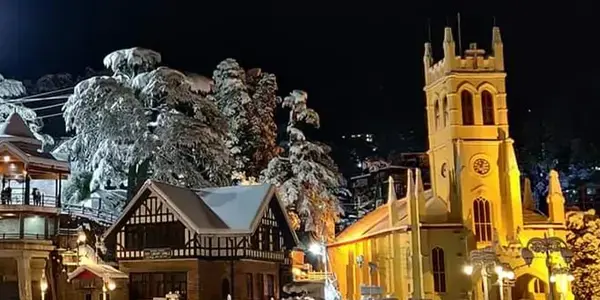

.webp)
Tara Devi Temple Shimla was founded in 1766 by King Bhupendra Sen of the Sen dynasty after he experienced a divine dream in the Juggar forest. The initial shrine featured a wooden idol of Goddess Tara, the family deity. In 1825, King Balbir Sen installed an Ashtadhatu metal idol atop Tara Parvat, carried ceremoniously by an elephant named Shankar. Perched at around 2,045 m, the current Kath‑kuni style stone‑and‑wood temple was extensively rebuilt in 2018 with modern amenities while preserving traditional carvings. Set amidst dense oak and rhododendron groves, the temple offers sweeping views of the Himalayas one way and the plains the other. It hosts important annual fairs during Navratri ...
.webp)
Packages Of Shimla
Classic hill-station charm with scenic views and cosy stays.

Places To Visit In Shimla
Top places to visit in Shimla, beautifully curated.
.webp)
Images Of Shimla
Discover Shimla’s colonial charm, hills and nature through images
Packages Of Shimla
Places To Visit In Shimla
Images Of Shimla


No entry fee; open daily 6 AM–7 PM
Dress modestly; avoid leather on shrine
Reach via taxi/bus + 3–4 km forest trek
Wear trekking shoes and carry water
Sunrise or late afternoon offers best skies
Festivals bring vibrant fairs and rituals
Photography allowed—capture panoramic views and cairns
Nearby sites: Shiv Bavdi shrine and Taradevi station tunnel
Spot pheasants and deer en route
Leave prayer stones standing—locals believe they carry answered wishes
Popular Foods Nearby:
Bhatt ki churkani (buckwheat pancake) and chai from forest-edge stalls
Street-style puri‑sabzi with local spices
March–June & Sept–Nov
Tara Devi Temple Shimla was founded in 1766 by King Bhupendra Sen of the Sen dynasty after he experienced a divine dream in the Juggar forest. The initial shrine featured a wooden idol of Goddess Tara, the family deity. In 1825, King Balbir Sen installed an Ashtadhatu metal idol atop Tara Parvat, carried ceremoniously by an elephant named Shankar. Perched at around 2,045 m, the current Kath‑kuni style stone‑and‑wood temple was extensively rebuilt in 2018 with modern amenities while preserving traditional carvings. Set amidst dense oak and rhododendron groves, the temple offers sweeping views of the Himalayas one way and the plains the other. It hosts important annual fairs during Navratri and Durga Ashtami, with devotional rituals, traditional crafts, and wrestling bouts. Free to enter and open daily from early morning to evening, the temple also features stories of pilgrims stacking cairns as wishful prayers. Today, Tara Devi Temple Shimla remains both a spiritual destination and a scenic escape, blending mythology, royal heritage, and natural beauty.
Altitude: ~2,045 m
Built in 1766; Ashtadhatu idol added 1825
2018 restoration in Kath‑kuni style
Free entry; open ~6 AM–7 PM daily
Hosts Navratri and Durga Ashtami fairs
Pilgrims build stone cairns as symbolic prayers
Mountainside Devotion & Visionary Kings: King Bhupendra Sen dreamt of Goddess Tara requesting a hill shrine during a hunt; he built a wooden temple in 1766. In 1825, King Balbir Sen installed the Ashtadhatu idol via an elephant named Shankar—infusing the temple with royal ritual and divine symbolism.
Wishes in Stone: Pilgrims stack cairns when asking for wishes. Locals say stones that stand firm mean Tara Devi smiled upon their prayer—prompting repeat visits and a quiet collective hope shared through centuries.
Hilly terrain is a dynamic landscape characterized by rolling or steep slopes, varying elevations, and a mix of hills, ridges, valleys, and plateaus. These features are the result of geological processes such as tectonic movements, erosion, and weathering over time.